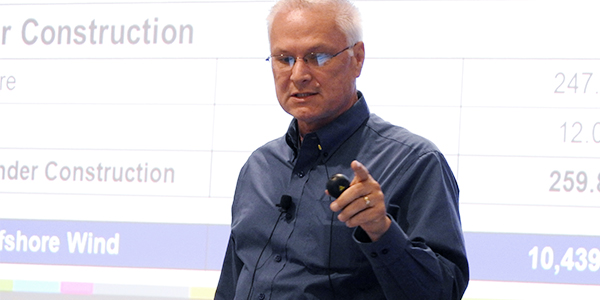VALLEY FORGE, Pa. — The PJM Planning Committee rejected a problem statement and issue charge on Thursday that sought to bring end-of-life supplemental projects under the purview of the RTO’s regional planning process.
American Municipal Power and Old Dominion Electric Cooperative said that although incumbent transmission owners play a major role in planning for the replacement of aging infrastructure, the process “should be broader, more inclusive and more transparent.”
TOs have said they don’t object to shining a light on their own analyses, but they believe new rules governing increased planning coordination belong in manuals, not the Tariff or Operating Agreement. The TOs also note that many replacement projects benefit from the expertise of local planners — a knowledge source that PJM can’t readily access. (See PJM Members Debate Dueling Tx Replacement Plans.)
After an extensive negotiating process, AMP and ODEC modified the issue charge to drop specific references to the OA, but it wasn’t enough to sway majority support. Only 39% of stakeholders approved the document in a sector-weighted vote.
Consumer Advocates: CIP-014 Projects Need More Transparency
The D.C. Office of the People’s Counsel wants to create language for PJM’s manuals, Tariff and OA that addresses future management of critical transmission assets on NERC’s CIP-014 list.
The issue came to a head last month when incumbent TOs asked for feedback on a Tariff attachment that details the process for vetting transmission system enhancements designed solely to remove critical assets from the CIP-014 list, of which fewer than 20 exist within the PJM footprint. NERC reliability standards deem these assets “highly critical … that, if rendered inoperable or damaged due to physical attack, could result in significant grid concerns: widespread instability, uncontrolled separation or cascading.”
At the Markets and Reliability Committee meeting in August, Consumer Advocates of the PJM States (CAPS) asked why the attachment wasn’t up for stakeholder discussion. The ensuing conversation revealed concerns among states and load interests that the TOs couldn’t provide enough transparency into development of the attachment, leaving yet another subset of supplemental projects “behind a veil.” (See PJM TO Tariff Filing Stirs up Transparency Concerns.)
“We appreciate the sensitive nature of these projects, but the advocates are wondering why the development of the process wasn’t brought through the stakeholder process,” said Greg Poulos, CAPS executive director.
In the problem statement and issue charge presented Wednesday, the D.C. OPC said the development of a process that protects confidential information about these assets and still fulfills the requirements of stakeholder participation outlined in PJM’s governing documents should involve all sectors. “This is a very sensitive subject,” said Pulin Shah, director of transmission strategy and contracts for Exelon. “We are concerned about reverse engineering and determining which assets these are. A lot of the deliverables that are outlined here go into areas that I know I’d be very uncomfortable talking about.”
Shah later clarified that TOs have adhered to a standard process outlined in the Consolidated Transmission Owners Agreement, which requests feedback from all stakeholders at least 30 days in advance of a Federal Power Act Section 205 filing at FERC. The TOs have already raised the issue with FERC and state commissions, he said.
PJM offered no opinion on whether the filing violates Tariff and OA rules, though Vice President of Planning Ken Seiler said staff are generally supportive.
“The elephant is in the room, so it’s not like we are ignoring it,” he said. “PJM conceptually supports the idea of electrically making critical facilities noncritical. We think that’s the best thing for this system.”
PJM Recommends Sunsetting Offshore Wind Special Sessions
After six special sessions that delved into PJM’s process for developing offshore wind projects, stakeholders have opted against recommending changes — for now.
John Reynolds, of PJM’s resource adequacy department, said 51% of stakeholders preferred the status quo over pursuing changes. Some of those changes included granting merchant TOs temporary capacity interconnection rights (CIRs) or modifying the generation request process and the studies that process involves.
Current rules allow merchant transmission developers to obtain transmission injection and withdrawal rights for DC facilities or controllable AC facilities connected to a control area outside the RTO. Under the problem statement approved in February, stakeholders considered allowing merchant transmission developers to request CIRs, or equivalents, for non-controllable AC transmission offshore. (See “PC Moves Forward on Offshore Interconnection Rights,” PJM PC/TEAC Briefs: Feb. 7, 2019.)
Reynolds said stakeholders felt the proposed changes gave offshore wind projects special treatment and could interfere with other queue projects. Instead of pursuing further changes, stakeholders said other topics deserved higher priority for the PC and suggested broadening future discussion of offshore wind development. He recommended sunsetting the special sessions for six months.
AEP Supplemental Projects
American Electric Power presented two supplemental projects for consideration at Thursday’s Transmission Expansion Advisory Committee meeting.
The first involves the second transformer at the Dumont 765-kV substation in eastern Indiana. AEP said the 25-year-old unit suffered a catastrophic failure in 2018.
At the Sullivan 765/345-kV substation in the southwestern corner of the state, AEP is seeking to replace a disconnected failed breaker after discovering the breaker’s current transformers were developing combustible gases.
— Christen Smith





